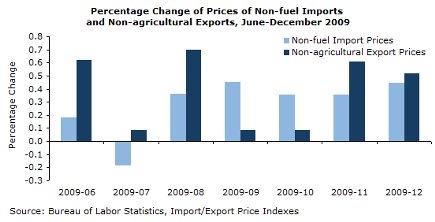January 15, 2010
January 15, 2010 (Prices Byte)
By David Rosnick
Falling rents continue to hold down core inflation.
The consumer price index rose 0.1 percent in December, slackening from 0.4 percent in November and 0.3 percent in October. Core inflation ticked up 0.1 percent after rising less than 0.05 percent in November. Core inflation has run at a 1.3 percent annualized rate in the second half of 2009, down from 2.3 percent in the first half of the year.
The largest contributor to inflation was transportation, the 0.4 percent increase in the month driven by a 2.5 percent jump in used car prices. The reduced supply of used vehicles resulting from the end of the cash-for-clunkers program has raised prices at a 36.4 percent annualized rate over the last three months.
The price of public transportation increased by 1.4 percent in December, having grown at a 22.4 percent annualized rate over the second half of the year. The other broad category leading price increases was apparel, at 0.4 percent, but this data is erratic, and has fallen at a 1.3 percent rate over the quarter.
After three months of decline, the price indices for rent and owner’s equivalent rent each remained flat in December. The oversupply of housing resulting from the housing bubble mean these components have been a significant source of price restraint overall. The non-rent core CPI grew at an annualized rate of 2.5 percent over the last six months compared to 1.3 percent in the overall core.
The fall in rents has been particularly pronounced in the South. In Washington, DC, where real house prices have fallen more than 34 percent since the peak in early 2006, (non-seasonally-adjusted) rents have fallen at a 1.2 percent rate since September. In Miami, rents are falling at a 2.6 percent annualized rate, having seen a 50 percent fall in real house prices. Atlanta, where the housing bubble was less pronounced (having fallen 24 percent in two years), has seen rent fall at a 4.7 percent rate over the last three months.
By comparison, rents in DC and Miami had risen at a 2 percent rate over the same months of 2008, while in Atlanta, rents had fallen at a slower 2 percent rate from September to December of the previous two years.
Medical care prices rose 0.1 percent, the 1.4 percent annualized growth well below the 3.0 percent average rate of the last six months. The fall in the rate of medical inflation is entirely due to non-prescription medical equipment and supplies, which fell 1.5 percent in December and at a 6.1 percent rate over the last three months compared to a 2.0 percent rise the prior quarter.
By contrast, prescription drug prices rose at a 2.7 percent rate over the last three months—relatively unchanged from the 2.6 percent in the quarter ending in September. Hospital services rose 0.5 percent and have risen at a 6.7 percent rate over the second half of the year.

The price of non-fuel imports rose 0.4 percent in December. With revisions, this is the fifth consecutive month of price inflation at a 4.9 percent annualized rate of growth, after a 5.5 percent fall over the twelve months ending in July. This reflects the fall in the value of the dollar over the second half of 2009 after the run-up in late 2008 and early 2009. After a 13.5 percent rise, the real broad-dollar index in December stood only 1.4 percent above the July 2008 level.
Non-agricultural export prices rose 0.5 percent in December, following November’s 0.6 percent increase. Some of this increase may reflect producers taking advantage of the fall in the dollar, raising prices in dollar terms as foreigners increase their purchasing power of American goods. A better picture will be available next week when the producer price index data is released.
David Rosnick is an economist at the Center for Economic and Policy Research in Washington, D.C. He received his Ph.D. in Computer Science from North Carolina State University and his M.A. in Economics from George Washington University.






